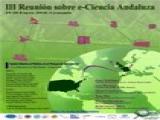Archivo de noticias y eventos
951 - 1000 de un total de 1805
También puede acceder a la lista de noticias publicadas en los medios relacionadas con el Instituto de Astrofísica de Andalucía - CSIC.
Pages

|
28/10/2010 - 14:00
On the discovery of the Zeeman effect on the Sun and in the laboratory The origin of the discoveries, both on the Sun and in the laboratory, of the action of a magnetic field on spectral lines, the so-called Zeeman effect, is discussed. The talk embraces the period from 1866, the first date of which the speaker is aware of observed evidences about the widening of spectral lines in sunspots (as compared to those formed in the photosphere), until 1908, the year in which the magnetic field in sunspots is definitely... José Carlos del Toro Iniesta |

|
21/10/2010 - 14:00
Umbral dots: clues to the internal structure of sunspots Sunspots have been studied since the time of Galileo, but they still remain one of the most active research fields in solar physics. Especially, research on the fine structure of sunspots made great progress with the advent of the Hinode satellite and CRISP spectropolarimetry at the Swedish Solar Telescope on La Palma. Umbral dots (UDs) are tiny bright points observed in the umbra of sunspots. They are scientifically interesting because they... Hiroko Watanabe |

|
15/10/2010 - 14:00
The Euler Characteristic as a Measure of the Topology of Cosmic Reionization After giving basic information about what and how we know about the epoch of reionization, I will very briefly introduce the cosmic reionization simulations which I am analyzing. Next, the concepts of topology and, in more detail, the Euler Characteristic are introduced. Only after providing the audience with this necessary background, I will present some results from the analysis of our cosmic reionization simulations. Martina M. Friedrich |

|
08/10/2010 - 12:30
El Centro Astronómico Hispano-Alemán: futura instrumentación y operaciones El Observatorio de Calar Alto cuenta en estos momentos con tres telescopios ópticos-infrarrojos y un conjunto de 11 instrumentos que cubren un gran rango de necesidades en distintos campos científicos, con una demanda desigual por parte de la comunidad astronómica. A partir del segundo semestre del 2010 se procederá a la apertura del archivo público del observatorio, optimizando la producción científica. Además, se están desarrollando dos... David Barrado |

|
07/10/2010 - 14:00
Características Morfológicas de los Espectros y los Entornos de las Estrellas OB Tbd Nolan Walborn |

|
30/09/2010 - 14:00
The Pipe Nebula: Primordial conditions of a quiescent molecular cloud We present the results of a new deep, near-infrared survey of the essentially starless Pipe Nebula, combining data from ESO, Calar Alto, and SPITZER telescopes, and the 2MASS survey. We use this new high sensitivity data set to construct dust extinction maps with spatial resolutions one order of magnitude smaller that the local Jeans Length. Our maps allowed us to determine the structure of the cloud down to and below the scale of dense pre-... Carlos Román Zúñiga |

|
16/09/2010 - 14:00
Active Galactic Nuclei at parsec scales We present a representative SED for low-luminosity AGNs, built from high-spatial resolution data for the LINERs and faint Seyferts in the sample. This distribution differs from those of bright Seyferts and Quasars, suggesting that the internal structure of AGNs appears to be largely determined by the amount of energy released by the central engine. On the other hand, we present a multiwavelength study of the nuclear star-formation (~2.5kpc x 2.... Juan Antonio Fernández Ontiveros |

|
09/09/2010 - 14:00
GO-IRS: a new multi-object spectrograph for the GTC GO-IRS stands for "GTC Optical Intermediate Resolution Spectrograph". It is the answer of a big team of over 100 experienced researchers and engineers from the University of Florida, China and Spain to the recent call for new instrumentation for the 10.4 m Gran Telescopio Canarias (GTC). The GO-IRS main facts are: 1000 MOS fibres in a 15 arcmin circular field of view; 4x400 IFU fibres in the central 2 arcmin; resolution powers of R=20k... José Antonio Caballero |

|
06/09/2010 - 14:00
Fundamental Constants in Time and Space According to the standard model of particle physics, fundamental constants, at least their low-energy limits, should be independent of time and location. Many fundamental constants of physics and astronomy are well defined locally. However, this "constancy of constants'' may not necessarily hold over the largest spatial and temporal scales, which are inaccessible by geological or astronomical studies of nearby targets. Now, advances in... Christian Henkel |

|
06/09/2010
Más de 200 investigadores se reúnen en Granada para debatir sobre la gravedad Los Encuentros Relativistas Españoles (ERE 2010) son una serie anual de conferencias sobre gravitación y relatividad que comenzaron en 1977 y que cuentan con un significativo reconocimiento internacional |

|
06/09/2010 - 10/09/2010
http://ere2010.iaa.csic.es Granada |

|
21/07/2010 - 15:00
Nubes interestelares, formación estelar, y fractales El medio interestelar tiene una estructura que es jerárquica y autosimilar, propiedades típicas de ciertos objetos geométricos llamados fractales. En esta charla (menos esotérica de lo que parece) explicare como hemos estado usando el análisis fractal para estudiar las propiedades de las nubes interestelares. También hemos estado estudiando la distribución de estrellas en cúmulos... Néstor Miguel Sánchez Doreste Sala de Juntas del Instituto de Astrofísica de Andalucía (IAA-CSIC) |

|
15/07/2010 - 14:00
The Square Kilometer Array. Should we all wait until 2022? The SKA, composed of several hundreds of 3 different types of antennas with separations up to 3000 km, and up to 200 square degrees FOV, can be considered as the largest, most sensitive, and most difficult radio telescope ever to be built. Some of the research areas where it will be able to provide fundamental answers include the dark era, when gas in galaxies was first turned in stars and the first black holes formed, star formation in nearby... Lourdes Verdes-Montenegro |

|
08/07/2010 - 14:00
Escalado de la variabilidad y la luminosidad en rayos X en fuentes ULXs Las fuentes Ultra-luminosas en rayos X (ULXs, del inglés Ultra-luminous X-ray sources) pueden ser la población que conecta los agujeros negros de nuestra Galaxia (<1000 MSol) y los objetos supermasivos en el centro de las galaxias (1E+05-1E+08 MSol). Éstos son los denominados agujeros negros de masas intermedias (1000-100000 MSol). Sin embargo su naturaleza aún no está clara. Recientemente hemos investigado la relación entre la amplitud de la... Omaira González Martín |

|
02/07/2010 - 14:00
An Initial Mass Function for Individual Stars in Galactic Disks The Initial Mass Function (IMF) has been derived by a variety of methods. Here we propose an IMF form (a Smoothed Two-Power Law psi_STPL) that approaches a power law at both low stellar masses (psi_STPL ~ m^(gamma)) and at high stellar masses (psi_STPL ~ m^(-Gamma)) with a turnover near the characteristic mass m_ch. The values of gamma and m_ch are derived from two integral constraints: i) the ratio of the number density of stars in the range m=... Antonio Parravano |

|
01/07/2010 - 14:00
Magnetic field configuration at the central region of our Galaxy It has been long debated whether the magnetic field configuration at the central region of our Galaxy is toroidal or poloidal. Previous works that have addressed this question were mainly based on radio observations of non-thermal radio filaments, and sub-mm polarimetric observations of dense molecular clouds. I will present a result of a wide-field near-infrared polarimetric survey of the central 2 deg by 2deg region; these wavelengths trace... Shogo Nishiyama |

|
30/06/2010 - 15:00
¿Qué es una partícula? Desde los inicios de la física, la idea de partícula ha jugado un papel fundamental en su formulación. Con la llegada de la mecánica cuántica, y más aun de la teoría cuántica de campos (la teoría cuántica que recoge además los postulados de la relatividad restringida), el concepto de partícula queda ligado indisolublemente al de onda. Sin embargo, ¿qu... Por Luis Cortés Barbado Sala de Juntas del Instituto de Astrofísica de Andalucía (IAA-CSIC) |

|
17/06/2010 - 14:00
Gamma Rays from the Relativistic Plasma Jets of Blazars X-ray and gamma-ray flares are a common occurrence in blazars, active galactic nuclei with relativistic plasma jets that are pointing almost directly at us. This talk will present the results of a comprehensive multi-waveband monitoring program of blazars with gamma-ray flares observed by the Fermi Gamma-ray Space Telescope. The relative timing of the flares at different wavebands and the emergence of bright radio knots moving down the jet at... Alan P. Marscher |

|
09/06/2010 - 15:00
CGC: una Cámara de Gran Campo para el OSN El Observatorio de Sierra Nevada (OSN) cuenta con dos telescopios principales de metro y medio (T150) y noventa centímetros (T90) de apertura. En la actualidad el T90 no dispone de ningún instrumento para obtener imágenes directas. El T150, por su parte, tiene acoplada de modo permanente una cámara CCD 2048 x 2048 que permite observar un campo de unos 8 minutos de arco, lo cual resulta demasiado pequeño para... Miguel Abril Martí Sala de Juntas del Instituto de Astrofísica de Andalucía (IAA-CSIC) |

|
27/05/2010 - 14:00
An overview of regional atmospheric phenomena on Mars Tbd Aymeric Spiga |

|
20/05/2010 - 14:00
2009 Año Internacional de la Astronomía: un año para recordar Hemos dicho adiós al Año Internacional de la Astronomía (AIA-IYA2009). En España nos propusimos organizar un Año de la Astronomía con un nivel de excelencia acorde con la magnífica evolución que esta rama de la ciencia ha tenido en nuestro país en las últimas décadas y lo hemos conseguido. Las cifras hablan por sí solas: más de 3100 actividades organizadas por al menos 1300 entidades con la participación de miles de personas que han convertido... Montserrat Villar Martín |

|
19/05/2010 - 15:00
¿Para qué (me) puede servir un GRID (del CSIC)? Desde hace unos años se está creando a nivel europeo una infraestructura de computación distribuida geográficamente (GRID). Este GRID permite solucionar problemas computacionalmente costosos o masivos y potencia la colaboración de científicos de diferentes lugares, ofreciendo las ventajas de un sistema distribuido frente a un sistema centralizado como los supercomputadores. El CSIC participa en esta... Antonio García Hernández, José Sabater Montes y Susana Sánchez Expósito Sala de Juntas del Instituto de Astrofísica de Andalucía (IAA-CSIC) |

|
13/05/2010 - 14:00
PLATO: The exoplanetary system explorer I present a general overview of the PLAnetary Transits and Oscillations of stars (PLATO) space mission. PLATO was recently approved by ESA’s Science Programme Committee, together with Euclid and Solar Orbiter missions, to enter the so-called definition phase, i.e. the step required before the final decision is taken (only two missions will be implemented). To be launched in 2018, PLATO is a third generation mission, which will take... Juan Carlos Suárez |

|
06/05/2010 - 14:00
The IAA cosmic dust laboratory Dust particles exist in a wide variety of scenarios ranging from the Earth's atmosphere to other planetary and cometary atmospheres in the Solar System, interplanetary medium, reflection nebulae, circumstellar disks, etc. Those dust particles play an important role in the radiative balance of the body under study. Light scattering properties of spherical particles can be easily computed from Lorenz-Mie theory. However, in the majority of the... Olga Muñoz Gómez |

|
29/04/2010 - 14:00
Molecular Gas and Star Formation in Local Early-Type Galaxies The molecular gas content of local early-type galaxies is constrained and discussed in relation to their evolution. First, as part of the Atlas3D survey, we present the first complete, large (>250 objects), volume-limited survey of molecular gas in normal local early-type galaxies, obtained with the IRAM 30m telescope. In particular, we find a surprisingly high detection rate of 23%, independent of mass and environment, but dependent on the... Martin Bureau |

|
28/04/2010 - 15:00
MODELADO DE GALAXIAS CON ESPECTRO DE LINEAS DE EMISIÓN DEBIDO A FORMACIÓN ESTELAR Generalmente se asume que el espectro de líneas de emisión de galaxias con formación estelar se puede modelizar mediante una única región HII. En este trabajo investigamos cuándo dicha aproximación es adecuada y cuándo el modelado se debe realizar mediante la emisión de un conjunto de diferentes regiones HII ionizadas por cúmulos de diversos tamaños. Con este fin... Marcos Villaverde Aparicio Sala de Juntas del Instituto de Astrofísica de Andalucía (IAA-CSIC) |

|
27/04/2010 - 15:00
Stellar cusps in gallactic nuclei We will give a brief introduction into stellar cusps in Galactic nuclei or, more in general, around massive black holes. We will treat topics such as: What is a stellar cusp? How does it form? What does the presence or absence of a stellar cusp tell us about a galactic nucleus? Is there a stellar cusp around the black hole at the center of the Milky Way? Pau Amaro-Seoane (AEI, Potsdam) and Rainer Schoedel (IAA, Granada) Sala de Juntas del Instituto de Astrofísica de Andalucía (IAA-CSIC) |

|
22/04/2010 - 14:00
Supermassive Black Holes Tbd Dr. Elena dalla Bontá |

|
15/04/2010 - 14:00
ALMA/CASA: You better get ready for them! ALMA is going to start its Early Science Observations during 2011 and a Call for Early Science with its compact array will be issued at the end of this year. At the same time, CASA, the software that ALMA users will have at their disposal, is being continuously developed. I will present an overview of a couple of workshops I attended in Manchester related to ALMA and CASA, which hopefully will encourage you to think for proposals with ALMA and... Miguel Ángel Pérez Torres |

|
07/04/2010 - 15:00
La PPN M 2-56: rápida evolución nebular gobernada por múltiples eyecciones post-AGB La etapa de Nebulosa Protoplanetaria (PPNe) o post-AGB comienza cuando las estrellas, con masas en la Secuencia Principal (SP) entre 0.6-8 masas solares, abandonan la Rama Asintótica de las Gigantes (AGB) y termina cuando alcanzan la fase de Nebulosa Planetaria (PNe). La duración de esta etapa de la evolución estelar es muy breve, de ~1000 años, sin embargo en ella se producen cambios radicales que afectan tanto a... Clara Cortijo Ferrero Sala de Juntas del Instituto de Astrofísica de Andalucía (IAA-CSIC) |

|
18/03/2010 - 13:00
Unfolding Properties of Mass Loss at the Tip of the Asymptotic Giant Branch In the final stages of stellar evolution low- to intermediate-mass stars lose their envelope in increasingly massive stellar winds. Matter, which has been processed inside these stars, is thereby returned to the interstellar medium, and mass loss also determines properties of subsequent planetary nebulae. In order to obtain properties of winds at the tip of the asymptotic giant branch we observed weak halos of a set of planetary nebulae in the... Christer Sandin |

|
17/03/2010 - 16:00
El arco iris como medidor de distancias cosmológicas. Comenzando con una breve introducción histórica, me gustaría aprovechar esta sesión CCD para presentaros, de una forma sencilla, qué son, por qué surgen, para qué se utilizan y por qué se han convertido en una herramienta tan importante los famosos “photometric redshifts”, en el marco de la cosmología moderna. Curvaturas, geometrías, dilataciones espacio... Alberto Molino Benito Sala de Juntas del Instituto de Astrofísica de Andalucía (IAA-CSIC) |

|
16/03/2010 - 13:00
OCTOCAM: A fast multichannel camera and spectrograph for the 10.4m GTC OCTOCAM is a high time-resolution multi-channel instrument that is being proposed for the 10.4m GTC telescope. It will perform simultaneous observations in 8 bands, covering the complete spectrum from the ultraviolet (u-band) to the near infrared (K-band) in a single exposure. An imaging mode will allow to observe a field of 2'x2' in all ugrizJHK bands, with the possibility to observe at time resolutions of up to 10 ms, while the spectroscopic... Antonio de Ugarte Postigo |

|
11/03/2010 - 13:00
Size matters This is a talk I gave last October in Freiburg as the opening key-note lecture of the "1st EAST-ATST Workshop". The American ATST (Advanced Technology Solar Telescope) and the European EST (European Solar Telescope) are projects for designing and building the new generation of large-aperture, solar telescopes. Both of the 4-m class constitute a technological breakthrough and promise a significant step forward in our understanding of... José Carlos del Toro Iniesta |

|
08/03/2010 - 10/03/2010
8th Workshop 'Estallidos de formación estelar' Granada |

|
04/03/2010 - 13:00
Structure and kinematics of the Milky Way's nuclear star cluster The Galactic center is a unique target for studying the properties of the nuclei of galaxies in general. The supermassive black hole, Sagittarius A*, that is located at the dynamical center of the Milky Way is surrounded by the densest and most massive star cluster of our Galaxy. In this talk I will focus on the most recent results of research on the structure and kinematics of the Milky Way's nuclear star cluster. Adaptive optics imaging is a... Rainer Schoedel |

|
25/02/2010 - 13:00
Testing spectral models for Stellar Populations High spectral resolution evolutionary synthesis models have become a routinely used ingredient in extragalactic work, and as such deserve thorough testing. Star clusters are ideal laboratories for such tests. In this talk I apply the spectral fitting methodology to a sample of clusters, mainly from the Magellanic Clouds and spanning a wide range in age and metallicity, fitting their integrated light spectra with a suite of modern evolutionary... Rosa González Delgado |

|
24/02/2010 - 16:00
e-Ciencia de la A a la Z Al hablar de e-Ciencia es complicado no mencionar los Grids. Al hablar de Grid es fácil relacionar con computación. Pero podemos ampliar este concepto pues, al fin y al cabo, un Grid viene a ser una malla que conecta cosas. Estas cosas están distribuidas geográficamente e interconectadas en red. De esta forma podemos tener no solo Grids de computación, sino también de datos o instrumentos, e incluso... Mamen Argudo Fernández (IAA) Sala de Juntas del Instituto de Astrofísica de Andalucía (IAA-CSIC) |

|
19/02/2010 - 18:00
Pulsating stars harbouring planets In this talk, I present a review of the current status of the very recent line of research linking stellar seismology and exoplanet search. I give a summary of the main exoplanet searching techniques and a general overview of stellar seismology. Some examples of the synergies between these two lines will also be given. If a star harbouring planets is found to be pulsating, our knowledge of the physical characteristics of these planets is... Andrés Moya Bedón |

|
16/02/2010 - 12:00
Extragalactic research with the Virtual Observatory Nowadays, following years of technological development, Virtual Observatory standards, resources, and services became powerful enough to help astronomers making real science on everyday basis. An astronomer is able to combine ``online'' VO-enabled parts with ``offline'' research stages including dedicated data processing and analysis, observations, numerical simulations. I will present three VO-science projects combining VO and non-VO blocks,... Igor Chilingarian |

|
11/02/2010 - 13:00
Observational constrains to galaxy evolution from the distribution of integrated stellar ages and metallicities in spiral galaxies I will present new results on the integrated stellar populations of bulges, bars and disks of spiral galaxies from long-slit spectroscopic observations. We have derived the ages and metallicities using both the whole spectra and stellar line-strength indices along the bar and bulges for a sample of 20 disk galaxies and derived the populations in the disks of four galaxies using GEMINI spectroscopic data. We find, in the distribution of stellar... Isabel Pérez Martín |

|
04/02/2010 - 13:00
First results of the Fermi Large Area Telescope The Fermi Large Area Telescope (Fermi LAT) is a pair conversion telescope sensitive to photons in the energy range 30 MeV to >300 GeV. It was launched on June 11th 2008 and has now been successfully operating for over a year and made breakthrough discoveries in high energy astrophysics. In this seminar I will give an overview of the results from Fermi LAT and the implication it has had in astrophysics and astro-particle physics. Gudlaugur Johannesson |

|
03/02/2010 - 11:00
Amoniaco en regiones de formación estelar masiva con condiciones extremas Hoy en día se piensa que se comprende bastante bien el proceso mediante el cuál se forman las estrellas de baja masa, sin embargo a día de hoy aún se sabe muy poco acerca de la formación de estrellas de alta masa. Los Nucleos Moleculares Calientes (NMC) se han propuesto como una de las etapas más tempranas en la formación de una estrella de alta masa, se piensan que en su interior ya existe una... Juan Manuel Mayén Gijón (IAA-CSIC) Sala de Juntas del Instituto de Astrofísica de Andalucía (IAA-CSIC) |

|
28/01/2010 - 13:00
The Galactic O-Star Spectral Survey (GOSSS) I present a large-scale spectral survey that is currently obtaining spectra of all known Galactic O stars down to B=13 with R=3000. The project includes additional observations of subsamples with [a] multi-epoch spectroscopy with R=40000, [b] flux-calibrated optical spectroscopy, and [c] high-spatial-resolution imaging. The main part of GOSSS is based on data from OSN, CAHA, and LCO. I will describe the current status of the survey and present... Jesús Maíz Apellániz |

|
21/01/2010 - 13:00
The First 3mm Polarimetric Survey of Radio Loud AGN Relativistic jets in AGN are the most energetic and among the most powerful astrophysical objects known so far. Their relativistic nature provides them the ability to emit profusely in all spectral ranges from radio wavelengths to TeV gamma-rays, as well as abrupt variability in all time scales (from hours to years). After an extended review of the present knowledge of these objects, but paying particular attention to blazars, the main results... Iván Agudo Rodríguez |

|
19/01/2010 - 16:00
Manejo básico de IDL IDL es un lenguaje de programación de alto nivel ampliamente extendido en el campo de la Astrofísica. Este seminario está enfocado a todos aquellos que se estén iniciando en IDL, y pretende introducirnos en el amplio abanico de posibilidades que éste ofrece para la lectura, análisis, procesado, técnicas de almacenamiento y representación de los datos científicos. Sin olvidar el... Javier Peralta Calvillo (IAA-CSIC) Sala de Juntas del Instituto de Astrofísica de Andalucía (IAA-CSIC) |

|
19/01/2010 - 20/01/2010
III Reunión sobre e-Ciencia Andaluza Granada |

|
18/01/2010
III Reunión de e-Ciencia Andaluza (e-CA) La reunión, que cuenta con más de ciento diez participantes en diversos ámbitos de investigación, cuenta con la presencia de destacados especialistas internacionales |

|
14/01/2010 - 13:00
Radio Supernovae: A Window into the Heart of Starburst Galaxies High-resolution radio observations of the nuclear regions of Luminous and Ultraluminous Infrared Galaxies (ULIRGs) have shown that their radio structure consists of a compact high surface-brightness central radio source inmersed in a diffuse low brightness circumnuclear halo. While the central components could be associated with AGNs or compact star-forming regions, where radio supernovae are exploding, it is well known that the circumnuclear... Antxón Alberdi |

|
10/12/2009 - 13:00
eXtreme Multiplex Spectrograph for the 3.5m Calar Alto telescope We'll describe the design and science case for the XMS spectrograph at the prime focus of the 3.5-m Calar Alto telescope that can deliver at least 4000 MOS slits simultaneously over a 1-deg field. This extreme multiplex capability means that 25000 galaxy redshifts can be measured in a single night, opening up the possibilities for large galaxy redshift surveys out to z~1 to study galaxy evolution by estimating galaxy group and cluster masses,... Francisco Prada & Santiago Becerril |